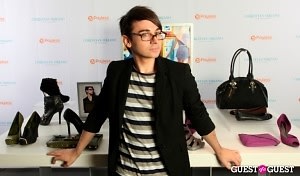 What Christian Siriano does do: design $20-to-$40 heels for Payless, a gig he's held down for three years. "For me, what’s so great about the collaboration and the collection is that it's just one season," he told me at a meet-and-greet and the Lexington Ave. Payless Monday night.
What Christian Siriano does do: design $20-to-$40 heels for Payless, a gig he's held down for three years. "For me, what’s so great about the collaboration and the collection is that it's just one season," he told me at a meet-and-greet and the Lexington Ave. Payless Monday night.
"We've been doing this for a while now. Ten seasons later, it's about the longevity, because customers shop that way." The 25-year-old won the fourth season of Project Runway at the ripe age of 22. Now he's running an eponymous fashion label with revenues well over $1.2 million. But—sadface—his trademark "tranny fierce fierce tranny tranny fierce" banter so ably skewered by Amy Poehler on SNL—is no longer his "thing."
"Any designer that's eccentric and in their office all day long," he explained, "they're going to say words that are descriptive and funny and weird. Listen, if you filmed Michael Kors all day long, you're gonna get some catchphrases. So I think that that just happened."
Perhaps he doesn’t want to own his sassy mantra because he took flack from gay groups for the perjorative use of “tranny,” but it’s more likely that he’s simply become a victim of a sunny corporate image, an image that has to stay in line with his remunerative parents at Payless.
 A phalanx of clipboard-clutching PR assistants outside the store had to badger passers-by to come in and meet the designer, and the line was never exactly overflowing. “You guys wanna meet Christian Siriano?” the girls called out, often on deaf ears. In terms of the fame quotient that Siriano brings to Payless, it seems that his star is a bit dimmed.
A phalanx of clipboard-clutching PR assistants outside the store had to badger passers-by to come in and meet the designer, and the line was never exactly overflowing. “You guys wanna meet Christian Siriano?” the girls called out, often on deaf ears. In terms of the fame quotient that Siriano brings to Payless, it seems that his star is a bit dimmed.
The business side of things at Payless is a bit dimmed as well. The WSJ recently reported that Payless is closing some 475 of its 4,500 stores in 2011. The bad news doesn’t seem to phase Siriano, who says that “the quality of the shoe and the fabrications are pretty much what everyone uses, it’s just that Payless has 4,000 stores, so it’s a little easier to make a price point when you’re producing a mass quantity of something. It’s just the business decision-making of, if there was, you know, 10,000 Givenchy stores, it would probably be the same price.”
Whatever the price, Christian’s designs for Payless are a steal. Whether it was his dream job to come out of Project Runway and design for a discount shoe brand is a question I’m not going to ask, but Christian seems altogether satisfied with his professional life and cultural portrayal. When I asked him whether he was okay with the SNL skit, he told me he was actually brought on set the day before to check it out. “I saw the wig that they were creating and met Amy. She was really cool, and listen, being on SNL, parodied, on one of her last seasons, is quite an honor for me.”
My Interview With Christian:
Do you think high fashion magazines will ever feature these shoes? Um, I mean, I think they advertise these shoes, for sure.
They’re not going to reject ad money. Yeah, they’re not gonna reject that. It’s interesting, because, what we do is, when we design the runway shoes, my runway collection that we do every season with Payless has probably been in every editorial we’ve had. Usually what happens is that when a stylist is pulling the look, they pull the full look. I kind of thought about it, and it’s actually been everywhere. Vogue, Elle, everything. Which is kind of nice to think about, that they do... It’s kind of cool, they show vintage shoes, so why not show a shoe that’s $30. How great.
Nina Garcia likes to use the word “cheap” as an insult on Project Runway. Do you think that you’re reclaiming “cheap”? I don’t really think of the shoes as being cheap really, because I think when Nina saying cheap she really means... I don’t know how she really means it.
Tacky? Maybe tacky, maybe not fashion-forward.
Tarty? Yeah, maybe. Not cool. Really, for me, the best thing about this is, the quality of the shoe and the fabrications are pretty much what everyone uses, it’s just that Payless has 4,000 stores, so it’s a little easier to make a price point when you’re producing a mass quantity of something, and that’s really what it is. It’s just the business decision-making of, if there was, you know, 10,000 Givenchy stores, it would probably be the same price.
Do you think the factory system works well? Do you go visit them and see what they’re doing over there? Oh my god, I see every single stage of the shoe process.
 In China?
Yeah, they produce everything in China, so what I see is every prototype stage, from the last to the mold to... It’s pretty amazing, they’re really responsive to showing me the steps because like, in all honesty, I can create something from nothing, so it’s easier for me to design something seeing it in between the processes than seeing before and after. I really have to see the whole process. And that’s really how you find design details. If you’re like, “Oh, I need to change that buckle,” or, “it needs a little bit more curve or a little bit more of a sharp edge.” Those are important.
In China?
Yeah, they produce everything in China, so what I see is every prototype stage, from the last to the mold to... It’s pretty amazing, they’re really responsive to showing me the steps because like, in all honesty, I can create something from nothing, so it’s easier for me to design something seeing it in between the processes than seeing before and after. I really have to see the whole process. And that’s really how you find design details. If you’re like, “Oh, I need to change that buckle,” or, “it needs a little bit more curve or a little bit more of a sharp edge.” Those are important.
At the factories, is it all safe standards? Do people like working there? I think so. Listen, it’s pretty fabulous. I think that’s what great about Payless. They’re really producing good quality shoes and that’s the most important thing.
As a kid, I have to say that I was a little afraid to go to Payless, because I felt that other kids would judge me for being “poor.” Is that still valid? You know, I think if you’re... Now that I’ve been doing this for over 3 years, that stigma kind of has gone away in a lot of places, because it’s all about mixing your style with something cheap and something expensive. I think what Payless has done, with its designer collaborations, with me and Isabel [Marant] and Lila?, even Pat Field, all of our collections really are for everyone in a way. I think it helps. I think the world of celebrity helps. You see so many of these iconic women, and they’re literally wearing tops from H&M with their $10,000 handbag. It’s kind of fabulous.
Do you think these collaborations help their brand become less down-market? For me, what’s so great about the collaboration and the collection is that it’s not a design collection or collaboration that’s one season. We’ve been doing this for a while now. Ten seasons later, that’s what it’s all about. It’s about the longevity, because customers shop that way. They like to go back for the next season. I think that that’s why it’s been so successful. If it was just a quick thing, I think people would go, “Eh, okay it’s great,” but I think that because all of us have been doing it for so many seasons, that’s what really makes it more special.
Have you seen any celebrities in your shoes? Almost every girl that comes to my show, we put them in my shoes. We had Sarah Hyland [from Modern Family], we had so many people. Gabrielle Union, Mena Suvari. Everyone who comes to the shows, we put them in the Payless shoes, which also makes it cool and special.
Has Heidi Klum or Nina Garcia worn your shoes out? Heidi hasn’t, because Heidi has a size 11 foot, and needs a Christian Louboutin. Nina, I’ve sent her clothes before, but I’ve never sent her shoes, so that’s good. That’s going to be on my next to-do list.

Send her some. Say, “Get these in Marie Claire.” Right? Get it in! We’ve been in Marie Claire though.
It’s interesting that she uses the word “cheap” so often because she does a recurring feature in her magazine where she picks the splurge version of an outfit and the more affordable one. They’re editors. They’re tough.
Have you had any negative feedback from colleagues, who are saying, “Oh, why are you doing this with Payless?” The fashion world can be pretty bitchy. It’s interesting. I think there’s always going to be negativity from somewhere—listen, we have to have it. But honestly, with this collaboration, the people who matter and count are really responsive, because this is really the way that fashion is moving forward. When the economy was really bad, let me tell you, there are some pretty big fashionistas on a budget. So I don’t think anyone can be so negative anymore.
A lot of people are negative about Obama and his reelection chances. Do you think we need to spend less with our lowered incomes? I don’t know. I think that fashion and those things make people feel better about themselves, and that’s how you have to live your life in a way. I’m feeling okay about it, shopping.
[Christian Siriano for payless via nymag]
Do you think this hampers your ability to sell higher-priced merchandise? When I first signed on, of course you have to think about it, but let me tell you, I think the feedback I get from clients is pretty amazing. We can sell a $10,000 Neiman Marcus gown. We do it all day long.
I was surprised to see the Payless collaboration because you’re so known for couture dresses. But I love the mix. It’s great: you have a $10,000 dress, you pair it with a $40 shoe. A $300 pant as well. I love to have all stages of price point.
Do you still say “tranny” and “fierce”? Not too much. Any designer that’s eccentric and in their office all day long, they’re going to say words that are descriptive and funny and weird. Listen, if you filmed Michael Kors all day long, you’re gonna get some catchphrases. So I think that that just happened.
It was part of your appeal! Yeah. I’m totally happy and it worked out.
Have you calmed down? It’s 40 hours a day into a one-hour episode, so you have to remember, it’s not an all-day thing. It’s a one-time-thing describing something, so it doesn’t really work out the same.
Did you see the SNL skit with Amy Poehler, where they parodied your “tranny” “fierce” dialogue? Yeah, of course! It was the perfect way, because it was funny and light-hearted, and that is why it was great.
Have you ever met her? Yeah, I met her the day before the skit was happening. She was funny, she was nervous.
Did she tell you what she was going to do? She did. I saw the wig that they were creating. She was really cool, and listen, being on SNL, parodied, on one of her last seasons, is quite an honor for me.




.jpg)
.jpg)



.jpg)
.jpg)
.jpg)




.jpg)